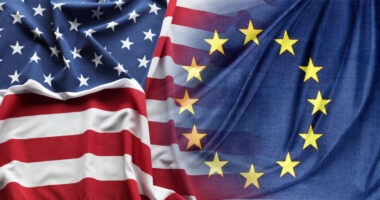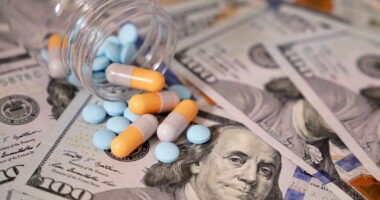Bayer Stepping Up its Pharma Focus
Bayer is making a large statement with recent moves to fortify its pharmaceutical business. Its $14.2 billion acquisition of Merck & Co.’s consumer healthcare business last week is the company’s latest.
Bayer announced last month its plan to focus entirely on its life-sciences businesses, healthcare and cropscience, and float its material science business on the stock market as a separate company. The company has already made several moves this year to show its commitment to its healthcare business, both prescription and the over-the-counter (OTC) pharmaceutical products. In its latest move, the company closed last week on its $14.2-billion acquisition of Merck & Co.’s OTC business. So where does Bayer rank in its pharmaceuticals? DCAT Value Chain Insights examines the company’s product and manufacturing positions in pharmaceuticals.
Bayer HealthCare: an inside look
Bayer HealthCare’s move to strengthen its focus in the life sciences comes as the company is coming off relatively slow revenue growth in 2013. In 2013, Bayer Healthcare posted sales of EUR 18.924 billion ($23.970 billion), a 1.7% increase over 2012, with an operating profit of EUR 3.260 billion ($4.129 billion). On a divisional basis, the Pharmaceutical Division is the company’s largest piece of Bayer HealthCare, representing 59.1% of Bayer Healthcare’s 2013 revenues. In 2013, the Pharmaceutical Division had sales of EUR 11.188 billion ($14.167 billion), a 3.6% increase over 2012. The Pharmaceuticals Division consists of two business units focusing on prescription products: general medicine, primarily consisting of women’s healthcare and cardiovascular health products; and specialty medicines, consisting of medicines that are mainly prescribed by specialist physicians.
 |
| Marijn Dekkers CEO Bayer AG Photo courtesy of Bayer AG |
Consumer Care is Bayer HealthCare’s second largest division, accounting for 20.6% of Bayer HealthCare’s revenues in 2013 with sales of EUR 3.904 billion ($4.944 billion), an increase of 1.3% over 2012. The main focus of the Consumer Care Division is on non-prescription medicines, dietary supplements, and dermatology products. The Medical Care Division represented 13.3% of Bayer HealthCare’s revenues in 2013 with sales of EUR 2.526 billion ($3.198 billion). Sales in the Medical Care Division declined by 4.7% in 2013.The Medical Care Division consists of the businesses with blood glucose meters, contrast-enhanced diagnostic imaging equipment with the necessary contrast agents, and mechanical systems for treating constricted or blocked blood vessels. The final piece of Bayer HealthCare is the company’s Animal Health Division, which provides medical products for livestock and companion animals. The Animal Health Division accounted for 6.9% of Bayer HealthCare’s 2013 sales with sales of EUR 1.306 billion ($1.653 billion), a 0.2% increase over 2012.
Consistent with that revenue distribution, among Bayer HealthCare’s 20 top-selling products in 2013, 12 were prescription pharmaceuticals (see Table I). Four were OTC products, three products were from the Medical Care Division, and one product line was from the Animal Health Division. Its four top-selling prescription drugs each exceeded $1 billion sales (based on exchange to US dollars). These drugs included the company’s number one and number two top-selling drugs: Kogenate (factor VIII or antihemophilic factor) for treating hemophilia A and Betaferon/Betaseron (interferon beta-1b) for treat relapsing forms of multiple sclerosis.
| Table I: Bayer Healthcare’s Top-Selling Products, 2013 | ||
| Product: Product (Proprietary Name) | Division | 2013 Sales |
| Kogenate | Pharmaceuticals | EUR 1.202 Bn ($1.523 Bn) |
| Betaferon/Betaseron | Pharmaceuticals | EUR 1.038 Bn ($1.315 Bn) |
| Xarelto | Pharmaceuticals | EUR 949 M ($1.202 Bn) |
| Yasmin/ YAZ/ Yasminelle | Pharmaceuticals | EUR 853 M ($1.081 Bn) |
| Nexavar | Pharmaceuticals | EUR 771 M ($977 M) |
| Contour | Medical Care | EUR 722 M ($914 M) |
| Mirena | Pharmaceuticals | EUR 719 M ($911 M) |
| Adalat | Pharmaceuticals | EUR 603 M ($764 M) |
| Advantage Product line | Animal Health | EUR 487 M ($617 M) |
| Aspirin | Consumer Care | EUR 464 M ($588 M) |
| Aspirin Cardio | Pharmaceuticals | EUR 452 M ($572 M) |
| Avalox/Avelox | Pharmaceuticals | EUR 426 M ($539 M) |
| Glucobay | Pharmaceuticals | EUR 423 M ($536 M) |
| Eylea | Pharmaceuticals | EUR 333 M ($422 M) |
| Ultravist | Medical Care | EUR 322 M ($408 M) |
| Alleve/Naproxen | Consumer Care | EUR 321 M ($407 M) |
| Bepanthen/ Bepanthenol | Consumer Care | EUR 310 M ($393 M) |
| Levitra | Pharmaceuticals | EUR 290 M ($368 M) |
| Canesten | Consumer Care | EUR 257 M ($326 M) |
| Gadovist | Medical Care | EUR 205 M ($260 M) |
| Bn is billions; M is millions. Currency exchange as of October 7, 2014 (1 EUR = $1.267) Source: Bayer AG/Bayer Healthcare |
||
Bayer: making the moves
Last month, Bayer announced that it intends to focus entirely on its life-sciences businesses, HealthCare and CropScience, and float its material science business on the stock market as a separate company. Bayer’s supervisory board unanimously approved the board of management’s plans. “Our intention is to create two top global corporations: Bayer as a world-class innovation company in the Life Science businesses, and MaterialScience as a leading player in polymers,” said Bayer CEO Dr. Marijn Dekkers in a company statement. Employment levels are expected to remain stable over the next few years, both globally and in Germany, according to Bayer.
In making the move, Bayer is emphasizing its recent activity in the life-sciences market, with the successful launch of novel pharmaceutical products, the acquisition of the OTC products business of Merck & Co. and development of its CropScience business. The company’s life-sciences businesses currently account for about 70% of Bayer’s sales and 88% of EBITDA (earnings before interest, taxes, depreciation, and amortization) before special items. The companies of the future Bayer Group had pro forma sales of approximately EUR 29 billion ($37 billion) in 2013. They will employ nearly 99,000 people, including about 29,500 in Germany. Corporate headquarters will remain in Leverkusen, Germany. Prior to the acquisition of Merck & Co.’s consumer healthcare business, Bayer HealthCare employed approximately 56,000 people.
“Bayer will continue as an enterprise with an attractive and balanced portfolio and a primary focus on organic growth,” Dekkers explained. To this end, the company intends to raise its research and development spending, selectively strengthen early research at the interface between HealthCare and CropScience, and continue driving the successful commercialization of recently launched pharmaceutical products. Bayer expects several products, the anticoagulant Xarelto (rivaroxaban), the eye medicine Eylea (aflibercept), the cancer drugs Stivarga (regorafenib) and Xofigo (radium 223 dichloride), and the pulmonary hypertension drug Adempas (riociguat) to have a combined peak annual sales potential of at least EUR 7.5 billion ($9.6 billion).
Bayer plans to float the MaterialScience business on the stock market as a separate company within the next 12 to 18 months. “A major reason for this move is to give MaterialScience direct access to capital for its future development. This access can no longer be adequately ensured within the Bayer Group due to the substantial investment needs of the Life Science businesses for both organic and external growth. Also, as a separate company, MaterialScience can align its organizational and process structures and corporate culture entirely toward its own industrial environment and business model,” said Bayer in its statement.
Following the intended flotation, MaterialScience will be Europe’s fourth-largest chemical company; it had global sales in 2013 of more than EUR 11 billion ($14 billion) (pro forma figure). The new company is planned to have a global workforce of roughly 16,800, including about 6,500 in Germany. It will have a new name and a separate identity and be headquartered in Leverkusen.
Bayer: strengthening its OTC business
The decision to focus on its life sciences businesses followed Bayer’s announced and now completed acquisition of the consumer care business of Merck & Co for $14.2 billion. The deal, which was announced in May 2014, was completed on October 1, 2014. “This acquisition is a milestone for Bayer, and we intend to continue the expansion of our attractive over-the-counter business both through organic growth and bolt-on acquisitions,” explained Dekkers. Bayer paid a purchase price of $14.2 billion, less certain contingent amounts held back that will be payable upon antitrust approvals in Mexico and the Republic of Korea. Integration of the acquired business has been successfully initiated. The combined consumer care business is headed by Erica Mann, member of the Bayer HealthCare Executive Committee and responsible for the Consumer Care Division.
The acquisition enhances Bayer’s OTC business across multiple therapeutic categories and geographies. Pro forma sales of the combined businesses in 2013 amounted to $7.4 billion (EUR 5.5 billion), with Merck & Co., Inc.’s business contributing approximately $2.2 billion. The acquisition will give Bayer the global number two position in non-prescription medication, behind the combined OTC businesses of Novartis and GlaxoSmithKline, following the completion of their announced joint venture in 2015, and ahead of the world’s previous industry leader Johnson & Johnson, according to Bayer. With the acquisition, Bayer says it is the OTC leader in North and Latin America and the leader in dermatology and gastrointestinal treatments, two of the five most important non-prescription health care product categories. The company has advanced to the number two position in the cold, allergy, sinus, and flu category and remains the number two in nutritionals and number three in analgesics, according to information from Bayer.
The consumer care business acquired from Merck & Co., Inc. is primarily comprised of products in the cold, allergy, sinus & flu; dermatology (including sun care); foot health; and gastrointestinal categories. The most important brands are Claritin (allergy), Copperton (sun care), MiraLAX (gastrointestinals), Afrin (cold), and in North and Latin America, Dr. Scholl’s (foot care). These brands complement Bayer’s existing OTC portfolio, which includes brands such as: Aspirin and Aleve in the analgesics category; dermatology products, including Canesten, and Bepanthen/Bepantho; nutritional brands such as Supradyn, One A Day, Berocca, Elevit, and Redoxon; antacids such as Rennie and Talcid; and cough-and-cold products such as Alka-Seltzer Plus and White & Black. The purchase price of $14.2 billion includes a payment associated with sales of Claritin and Afrin in certain countries where these products are still prescription-only.
Bayer expects the integration of the businesses to generate cost synergies, particularly in marketing spend and cost of goods, in the neighborhood of $200 million per year by 2017. Revenue synergies from increased commercial presence and leveraging Bayer’s global infrastructure in key growth regions to roll out the Merck brands ex-US are expected to amount to approximately $400 million by 2017. Bayer anticipates one-time costs of approximately $500 million for executing the transaction and combining the businesses, primarily in 2014/2015. Approximately 2,000 employees from Merck & Co., Inc. and 8,800 from Bayer will be brought together under one roof in Bayer’s new consumer care business. In a press statement, Bayer said that the integration process is off to a successful start with the decision on appointments to the top two management levels. The third management level is expected to be completed in the autumn of 2014. The management team of the merged businesses will be located at existing Bayer sites in Whippany, New Jersey; Basel, Switzerland; Shanghai, China; Leverkusen, Germany; and Singapore.
In addition to striking a deal with Merck & Co. for its consumer care business of Merck, Bayer also formed a collaboration with Merck in prescription drugs in the field of soluble guanylate cyclase (sGC) modulators. Bayer plans to strengthen its development options in its cardiology business with the global co-development and co-commercialization agreement, which has already been approved by the relevant antitrust authorities. Merck & Co., Inc. will make payments of up to $ 2.1 billion to Bayer. These include an up-front payment of $1 billion, which is to be paid shortly after completion as well as revenue-based milestone payments of up to $1.1 billion for future combined sales of certain jointly developed substances, including the pulmonary hypertension treatment Adempas (riociguat).
Bayer: recent manufacturing investment
On the manufacturing front, early this year Bayer announced an investment of more than EUR 500 million ($695 million) at its sites in Wuppertal and Leverkusen, Germany, Bayer will establish additional capacities for the manufacturing of the recombinant factor VIII (rFVIII) hemophilia products that are currently in development. The investigational therapy options for hemophilia patients, a plasma protein-free rFVIII (BAY 81-8973) and a long-acting rFVIII (BAY 94-9027), are both currently in Phase III clinical trials. In February 2014, Bayer HealthCare announced positive results from the PROTECT VIII trial evaluating Bayer’s site-specific PEGylated rFVIII (BAY 94-9027). As part of this investment Bayer HealthCare will create about 500 new jobs at its sites in Leverkusen and Wuppertal by the year 2020.
The investigational plasma protein-free product BAY 81-8973 is an upgrade of the currently marketed Kogenate FS/Kogenate Bayer product and will be produced without the addition of any components of animal or human origin. Subject to the results of the ongoing clinical trials, Bayer is planning to file BAY 81-8973 for approval with the regulatory authorities in the second half of 2014 with first launches planned in the fourth quarter of 2015. Bayer’s approved hemophilia A therapy product Kogenate FS/Kogenate r is manufactured exclusively in Berkeley, California. Establishing an additional supply source in Germany will help the company to prepare for production of the anticipated new therapy options and address the growing demand in this therapeutic area, according to the company.
Furthermore, a site-specific PEGylated rFVIII product currently being investigated may result in a significant benefit for long-term outcomes and quality of life improvements for people with hemophilia A. Current prophylactic treatment for hemophilia patients makes it necessary that patients infuse themselves two to three times a week. The investigational product BAY 94-9027 is a long-acting factor VIII that is being studied in patients in a once-weekly prophylactic dosing regimen. Bayer HealthCare recently announced positive results with the site-specific PEGylated rFVIII product demonstrating protection from bleeds comparable to current prophylactic dose regimens with infusion intervals of up to seven days. Bayer is planning to file BAY 94-9027 for approval with the regulatory authorities in the second half of 2015.
Also, earlier this year, Bayer HealthCare announced it will invest around EUR 100 million ($138 million) to increase the production capacity of its plant in Beijing, China, in preparation for further demand of its products in the country. The planned capacity expansion is designed to ensure a reliable supply of products to meet the domestic demand for Bayer HealthCare’s products, including the company’s cardiovascular and anti-diabetes products. The expansion will include logistics areas for fully automated material handling, analytical laboratories, and high-speed packaging lines.
.





